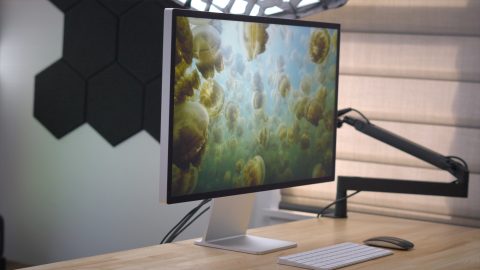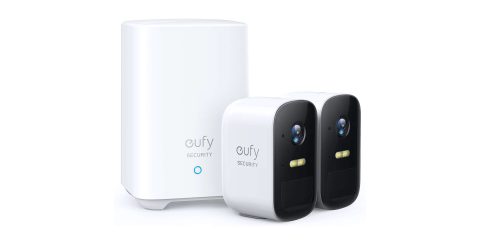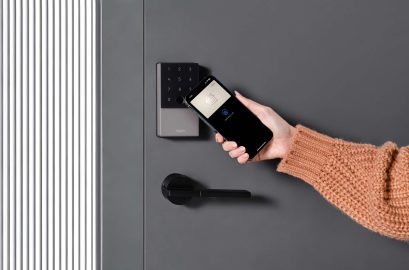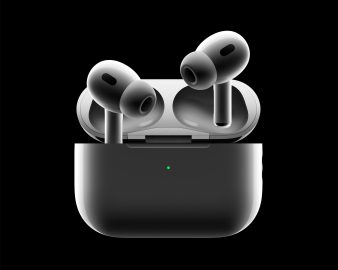
Samsung unveiled its latest generation of flagship smartphones today at its Unpacked 2019 event as well as some new accessories. Along with the expected Galaxy S10e, S10, and S10+, the company kicked off Unpacked by showing off the Galaxy Fold, a foldable smartphone/tablet hybrid that will go on sale in April for a salty $1,980.
Galaxy Fold
While Samsung certainly innovated to bring the Galaxy Fold to market this year, it will have some unique drawbacks as it packs a 4.6-inch front display along with 7.3-inch interior display when unfolded. The device includes six cameras, and has 12GB of RAM with 512GB of storage.
The device has notably chunky bezels on the top and bottom of the 4.6-inch display that’s used when folded. One of the biggest drawbacks for users could be the thickness of the device, along with the price tag of $1,980. For a size comparison, Apple’s iPad mini has a 7.9-inch screen size, just a bit larger that the 7.3-inch display size of the Galaxy Fold when opened up.

Our sister-site 9to5Google is currently covering the Unpacked Event in-person and noted more details:
A USB-C port is located and centered on the right-half, while speakers are on the other side. The volume rocker and power button, which doubles as a fingerprint sensor, is on the right-edge. Two batteries combine for 4,380mAh capacity, while the Galaxy Fold features threes cameras on the back, two in tablet mode, and one up front.
Galaxy S10e, S10, and S10+
Until now, Samsung has released two versions of its high-end flagship smartphone. Today, the company is following in Apple’s footsteps and releasing three S10 smartphones, a more budget-focused S10e and two more powerful and pricier models with the S10 and S10+.
However, a bit different than Apple’s iPhone XR and XS strategy, Samsung’s $750 Galaxy S10e has the smallest display size of 5.8-inches, the S10 sports a 6.1-inch display, with the S10+ coming with a 6.4-inch panel. The company will also be releasing a S10+ with 5G connectivity that features an even larger 6.7-inch display.

Another difference between Apple’s current iPhone lineup and the new S10 devices is pricing. Samsung has its standard S10 priced starting at $900, with the S10+ at $1,000, $100 less than Apple’s iPhone XS and XS Max, respectively. The S10 smartphones also feature WiFi 6 (802.11.ax) support and come with storage capacities up to 1TB.
Under the hood, the Galaxy S10 and S10+ both use a Snapdragon 855 processor. That’s paired with at least 8GB of RAM on both devices, with an optional 12GB on the S10+. 128GB of storage is available as the base option, with 512GB and 1TB options available on the S10+, and the latter on the S10. microSD cards are still supported as well.
Other major features for the S10 and S10+ include reduced bezels with the new “Infinity-O” display that uses a double hole-punch notch to maximize screen-to-body ratio, an ultra-wide 16MP camera sensor as a part of the triple-camera setup, and wireless power sharing via the back of the device.
The Samsung Galaxy S10 device will become available starting March 8th.

Galaxy Buds
Samsung also announced its latest AirPods competitor, the Galaxy Buds. These evolve on the company’s Gear IconX fully wireless earbuds and include a Qi-based wireless charging case and new quick pairing software that mirrors AirPods’ seamless experience. A handy feature will certainly be Samsung users being able to charge up their Galaxy Buds with the wireless power sharing feature of the new S10 smartphones.

Galaxy Watch and Galaxy Fit
The Galaxy Fit is in the vein the Fitbit’s more basic smart wearables but with a full touchscreen:
Samsung continues to differentiate its fitness band by using a full color touchscreen. Notable specs of the Galaxy Fit include a .95” AMOLED display at 120 x 240 and 282 PPI. There is a 120mAh battery rated at a week of usage, and a “Realtime OS” — not Tizen — that features an “intuitive UX and a user-friendly smart experience.”
The Galaxy Watch is a more full-featured, but budget friendly smart watch at $200 that will include blood pressure monitoring.
As for health features, Samsung is packing pretty much everything you’ll find on the typical Samsung Galaxy Watch. That includes support for step tracking and heart rate monitoring, but also sleep tracking and more. Samsung is also adding blood pressure monitoring to the Galaxy Watch Active for the first time in any of its wearables.
Read more about Samsung’s Unpacked Event at 9to5Google:
- Samsung’s Galaxy Fold is the first Android Foldable, available this April for $1,980
- Samsung Galaxy S10, S10+ go official w/ ‘Infinity-O’ display, triple cameras, Snapdragon 855, $900
- Samsung announces the Galaxy S10e, the first ‘budget’ Galaxy S device
- Samsung’s first 5G smartphone is a super-charged Galaxy S10 w/ 6.7-inch display, 4,500 mAh battery
- Samsung announces their latest truly wireless earbuds, the Galaxy Buds
- Samsung Galaxy Watch Active goes official w/ no rotating bezel, blood pressure monitoring, $200
- Samsung’s Galaxy Fit is a dedicated fitness tracker w/ week-long battery life
FTC: We use income earning auto affiliate links. More.







Comments